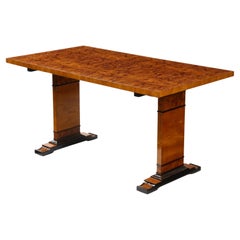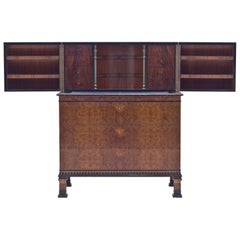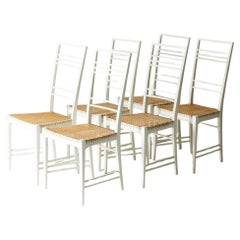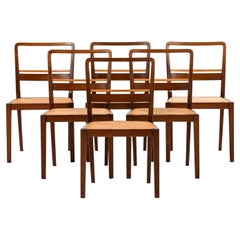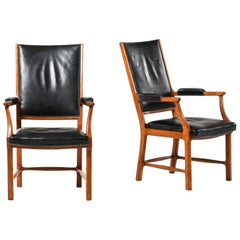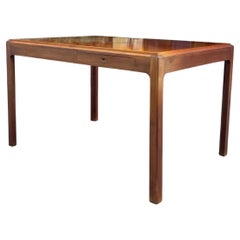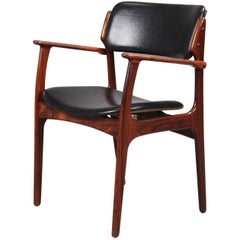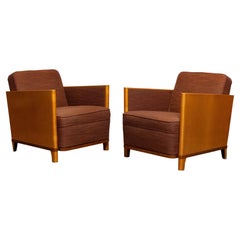Erik Chambert Furniture
to
6
1
7
5
1
1
7
7
2
3
1
7
3
3
2
2
7
7
7
7
7
7
7
7,546
3,967
2,548
2,244
Creator: Erik Chambert
Swedish Grace Elmroot Table, Circa 1940s
Located in New York, NY
A Swedish Grace, elm, elm root and ebonized table or desk by Erik Chambert, with a rectangular top raised on rectangular supports with leaf-tip carving and carved scrolled feet.
Category
1940s Swedish Scandinavian Modern Vintage Erik Chambert Furniture
Materials
Elm
Swedish Grace Chiffonier by Erik Chambert for Chamberts Möbelfabrik, 1930s
Located in Uppsala, SE
This Swedish grace chiffonier was designed by Erik Chambert during the 1930s for his own company, Chamberts Möbelfabrik. It displays a very high quality of craftsmanship, with a wide...
Category
1930s Swedish Art Deco Vintage Erik Chambert Furniture
Materials
Felt, Elm, Rosewood
Set of Six "Poem" Dining Chairs by Erik Chambert, Sweden, 1950s
Located in Stockholm, SE
Set of six “Poem” dining chairs by Erik Chambert, made from white lacquered wood with rattan seats.
The model was first presented in 195...
Category
1950s Swedish Scandinavian Modern Vintage Erik Chambert Furniture
Materials
Rattan, Wood
Erik Chambert Dining Chairs Produced by AB Chamberts Möbelfabrik in Norrköping
Located in Limhamn, Skåne län
Rare set of 6 dining chairs designed by Erik Chambert. Produced by AB Chamberts Möbelfabrik in Norrköping, Sweden.
Category
1930s Swedish Scandinavian Modern Vintage Erik Chambert Furniture
Materials
Cane, Mahogany
Erik Chambert Armchairs Produced by Chamberts Möbelfabriker
Located in Limhamn, Skåne län
Rare pair of armchairs designed by Erik Chambert. Produced by Chamberts möbelfabriker in Norrköping, Sweden.
Category
1940s Swedish Scandinavian Modern Vintage Erik Chambert Furniture
Materials
Brass
Erik Chambert Armchairs Produced by Chamberts Möbelfabriker in Norrköping
Located in Limhamn, Skåne län
Rare pair of armchairs designed by Erik Chambert. Produced by Chamberts Möbelfabriker in Norrköping, Sweden.
Category
1940s Swedish Scandinavian Modern Vintage Erik Chambert Furniture
Materials
Leather, Mahogany
Set of Six Dining Chairs “Poem” Designed by Erik Chambert, Sweden. 1953
Located in Stockholm, SE
Set of six dining chairs “Poem” designed by Erik Chambert,
Sweden. 1953.
Lacquered birch and cane.
This extraordinarily light and delicate high-backed chair design called “the Poem Chair...
Category
Mid-20th Century Swedish Mid-Century Modern Erik Chambert Furniture
Materials
Cane, Birch
Related Items
Cuban Mahogany Drawing Table, Denmark, 1940s
Located in London, GB
A cuban mahogany drawing table with central compartment, side drawer, and reversible lid, made in Denmark by a master cabinetmaker between 1940-1950.
The deep proportions of this e...
Category
1940s Danish Vintage Erik Chambert Furniture
Materials
Mahogany
1960s Erik Buch Fully Restored Armchairs in Rosewood, Inc. Reupholstery
By Oddense Maskinsnedkeri, Erik Buch
Located in Knebel, DK
Erik Buch fully restored armchairs in rosewood with excellent woodwork that are evidence of Good Design and craftsmanship.
The chairs feature a solid rosewood construction with Erik...
Category
1950s Danish Scandinavian Modern Vintage Erik Chambert Furniture
Materials
Fabric, Rosewood
H 31.5 in W 24.02 in D 21.26 in
Set of Six Erik Christiansen ‘Boomerang’ Teak Dining Chairs
By Erik Christensen
Located in Middlesex, NJ
Set of six Erik Christiansen ‘Boomerang’ teak dining chairs
Captain chairs:
22” D x 21.5” W x 31.5 H
18.25 seat height.
Category
20th Century Danish Mid-Century Modern Erik Chambert Furniture
Art Deco Desk, France 1940s
Located in Greding, DE
Art Deco desk with slightly curved table top and two drawer elements with four drawers each. These are lockable and the handles are made of elegant bars. The desk can be positioned a...
Category
1940s French Art Deco Vintage Erik Chambert Furniture
Materials
Wood
1940s Art Deco Midcentury Italian Walnut Burl Glass Writing Desk Table
Located in Carimate, Como
Beautiful Italian Art Deco Mid-Century Modern desk writing table, in wood with elegant carved frame, curved sides and glass top highlighted by the two drawers with beautiful brass ha...
Category
Mid-20th Century Italian Art Deco Erik Chambert Furniture
Materials
Brass
H 30.32 in W 40.16 in D 21.26 in
Period Art Deco Bedside Chests 1930s Nightstands
Located in Potters Bar, GB
Pair of Art Deco Birds Eye Maple Bedside Cabinets.
These Stylish Cabinets Feature Wonderful Birds Eye Maple Veneers to the Fronts, Tops and Sides.
Each Cabinet Has 1 Interior Shelf a...
Category
1930s Art Deco Vintage Erik Chambert Furniture
Materials
Mahogany
Swedish deigner pine dining chairs produced by Åby Möbelfabrik, 1930s
By Axel Einar Hjorth
Located in Eskilstuna, SE
Sports cabin pine chairs by Swedish designer. Produced by Åby Möbelfabrik during the 1930s.
Good set of six chairs with original patina.
Category
Mid-20th Century Swedish Scandinavian Modern Erik Chambert Furniture
Materials
Pine
1960s Erik Buch Set of Six Rosewood Dining Chairs by Oddense Maskinsnedkeri
By Oddense Maskinsnedkeri, Erik Buch
Located in Knebel, DK
Set of 6 model 49 dining chairs in rosewood with floating seat designed by Erik Buch for Oddense Maskinsnedkeri.
The model 49 chairs are becoming increasingly collectable with the...
Category
1960s Danish Scandinavian Modern Vintage Erik Chambert Furniture
Materials
Rosewood
H 31.11 in W 19.3 in D 21.66 in
Swedish Designer, Chest of Drawers, Pine, Sweden, 1930s
Located in High Point, NC
A chest of drawers designed and produced in Sweden, c. 1930s.
Category
1930s Swedish Scandinavian Modern Vintage Erik Chambert Furniture
Materials
Pine
1940s Paul Laszlo Freeform Desk
By Paul Laszlo
Located in Oakland, CA
53" W x 26.5" D x 29.75" H
1940s "Freeform desk" by celebrated designer, Paul Laszlo for Brown Saltman. Constructed in oak with a playfully curved top, this desk, like so much of La...
Category
1940s North American Art Deco Vintage Erik Chambert Furniture
Materials
Oak
The Nº2 Armchair. Produced in Solid Jequitibá Design by Amilcar Oliveira
Located in São Paulo, SP
Armchair No. 2 pays tribute to the Brazilian modern furniture of the 1950s and 1960s. Its sturdy and comfortable structure uniquely blends relaxation with sophistication. Crafted met...
Category
21st Century and Contemporary Brazilian Modern Erik Chambert Furniture
Materials
Leather, Wood, Foam
H 30.71 in W 23.63 in D 23.63 in
Vintage Danish Teak Dining Chairs by Kjærnulf for Vejle Møbelfabrik, 1960s
By Henning Kjærnulf, Vejle Stole & Møbelfabrik
Located in Asaa, DK
Vintage danish teak dining chairs by Kjærnulf for Vejle Møbelfabrik 1960s
Set of four dining chairs in teak designed by Danish architect Henning/Hen...
Category
1960s Danish Scandinavian Modern Vintage Erik Chambert Furniture
Materials
Teak
H 29.53 in W 19.49 in D 18.9 in
Previously Available Items
Swedish Grace Cabinet by Erik Chambert, Sweden, 1920s
Located in Stockholm, SE
Elegant mahogany cabinet by Erik Chambert, with drawers in the wider bottom part. Dramatic root veneer on the cabinet doors, decor of intarsia. Round brass handles...
Category
1930s Swedish Scandinavian Modern Vintage Erik Chambert Furniture
Materials
Mahogany
Matching Pair Art Deco Chairs with Elm Base and Dark Brown Wool by Erik Chambert
Located in Silvolde, Gelderland
Beautiful and rare matching set of two Art Deco club / lounge chairs with elm veneered frame upholstered with original dark brown melle fabric which is still in very good and comfort...
Category
1930s Swedish Art Deco Vintage Erik Chambert Furniture
Materials
Wool, Elm, Pine
H 26.38 in W 26.38 in D 28.35 in
Set of Eight "Poem" Dining Chairs by Erik Chambert, Sweden, 1950s
Located in Stockholm, SE
Set of eight “Poem” dining chairs by Erik Chambert, made from white lacquered wood with rattan seats.
The model was first presented in...
Category
1950s Swedish Scandinavian Modern Vintage Erik Chambert Furniture
Materials
Rattan, Wood
Functionalist Cabinet Attributed to Erik Chambert, Sweden, 1930s
Located in Stockholm, SE
Striking functionalist cabinet by Erik Chambert, with a wide base and slimmer upper section. Lower section made from dark wood with an elegantly ...
Category
1930s Swedish Scandinavian Modern Vintage Erik Chambert Furniture
Materials
Birch
Erik Chambert Swedish Art Deco Scandinavian Modern Marquetry Lounge Chairs
Located in New York, NY
Elegant pair of Swedish art deco armchairs / lounge chairs designed by Erik Chambert. Chairs feature a sleek wood veneered frame in rosewood and birch veneer and a beautifully render...
Category
Mid-20th Century Scandinavian Scandinavian Modern Erik Chambert Furniture
Materials
Rosewood
H 31.25 in W 33 in D 25.25 in
Functionalist Cabinet by Erik Chambert for Chamberts Möbelfabrik, Sweden, 1930s
Located in Stockholm, SE
Stately functionalist cabinet by Erik Chambert, made from birch with birch root inlays. Large round brass door handle that splits seamlessly when...
Category
1930s Swedish Scandinavian Modern Vintage Erik Chambert Furniture
Materials
Brass
H 53.94 in W 48.04 in D 21.66 in
Erik Chambert Credenza, circa 1940s
Located in New York, NY
A Swedish inlaid and stained birch sideboard, designed by Erik Chambert, circa 1940s, the rectangular top with a molded edge above two cupboard doors and a central tilting bottle com...
Category
1940s Swedish Scandinavian Modern Vintage Erik Chambert Furniture
Materials
Birch
Erik Chambert Swedish Art Deco Floor Clock in Rosewood and Decorative Marquetry
Located in New York, NY
Erik Chambert, Swedish Art Deco floor clock in rosewood and decorative marquetry depicting stylized foliage. The clock’s face is polished pewter w...
Category
Mid-20th Century Scandinavian Scandinavian Modern Erik Chambert Furniture
Materials
Pewter
H 73 in W 14.5 in D 7 in
Erik Chambert, Very Rare Pair of Chairs, AB Chamberts Möbelfabrik, 1937
Located in Uppsala, SE
Very rare pair of chairs designed by Erik Chambert in 1937 and produced by his own company AB Chamberts Möbelfabrik. Frame made of ash with cane seat. This exact model was displayed ...
Category
1930s Swedish Scandinavian Modern Vintage Erik Chambert Furniture
Materials
Cane, Ash
H 30.71 in W 18.51 in D 18.51 in
Erik Chambert Walnut Mirror, Swedish Modern, 1930s
Located in Skanninge, SE
Unusual mirror by Erik Chambert for Chamberts Möbelfabrik in Norrköping.
Really good quality and perfect condition.
Erik Chambert (1902-1988) was one of the first interior designers to graduate from Högre Konstindustriella Skolan (now the University College of Arts, Crafts, and Design, Konstfack) in 1925. Before that, he had been awarded a silver medal for his apprentice piece in cabinet-making. He and his brother, the master cabinet-maker Otto, ran the family furniture-making business AB Chamberts Möbelfabrik in Norrköping, with Erik as the artistic director. The company had been founded in 1883 by their father, Axel Chambert.
As an interior designer, Erik Chambert’s first major assignment was for the Stockholm Exhibition in 1930, where he designed the functionalist interior for an apartment by the recently-appointed municipal architect of Norrköping, Kurt von Schmalensee. Gotthard Johansson expressed his opinion on Chambert’s participation in the daily paper Svenska Dagbladet: “where simplicity has not become indigent, nor functionalism dogmatic”. The senior curator for the Stockholm Exhibition, Gregor Paulsson, commented on the apartment in an appreciative letter to Erik Chambert: “As for my personal opinion, I would like to say unconditionally that I consider it to be the biggest success of the entire exhibition. It is in keeping with the spirit we wished to achieve.”
Erik Chambert designed practical, comfortable and timeless furniture in a functionalist style that gave a blond, sober impression. Helena Dahlbäck Lutteman has called the style “humane functionalism”. Study trips around Europe after his graduation acquainted Erik Chambert with the Bauhaus school and Art Concrete. He was influenced by contemporary trends but reformulated what he saw and experienced in his style. For the Stockholm Exhibition, he designed a folding recliner with light wood construction and red varnished armrests in steel. This was the only time he used this particular material that was fashionable during that period. Källemo AB in Värnamo began making replicas of the recliner and other classics by Erik Chambert in recent decades. One of these new recliners is currently standing in the library of Arkitektur- och designcentrum (earlier Arkitekturmuseet) in Stockholm. Erik Chambert believed that a piece of furniture should be functional and blend with the surroundings. A work desk with a reversible pine top, one side for work and the other for more festive occasions, with a shelf construction of wood slats underneath for paper and drawings, was shown at an exhibition in Zurich in 1949. Usually, his designs were only produced in one or very few copies. The chair “Poem” from 1953 is a rare exception.
The year before he died, Erik Chambert said, “Exhibitions have been my life.” As a furniture designer, he participated in numerous prestigious international exhibitions together with AB Chamberts Möbelfabrik: Chicago in 1933, the world fairs in Brussels and Paris in 1935 and 1937 respectively, the international crafts exhibition in Berlin in 1938 and the world exhibition in New York in 1939.
Erik Chambert gave vent to his visual creativity when he designed furniture. This is evident, for instance, in the rich marquetry he made to order or for exhibitions. He took a delight in creating entire pictures, not just patterns, in marquetry, depicting figures or cityscapes in different woods. He often combined these with shimmering mother of pearl and metals. In 1945, he designed the cabinet “The Scales of Life”, now in the Nationalmuseum collection. The marquetry inlayer was Manne Manning. The cabinet was based on an eponymously titled gouache from 1943.
As an interior designer, Erik Chambert was frequently commissioned for public spaces and private homes. Most assignments were from institutions and private companies in and around Norrköping, but his clients also included Haga Palace and the Tessin Palace, through the National Board of Public Buildings. In addition to suggesting furniture and textiles, he was involved in deciding the color schemes for walls, designing fabrics, sometimes for specific purposes, composing tapestries and a few larger curtains with appliqué work. In the book “Svenska Textilier 1890-1990” (Swedish Textiles 1890-1990), Anne-Marie Ericsson writes, “An interesting example is the furniture designer Erik Chambert, who allowed both his disciplines, as an artist and a designer, to merge in his rhythmically distinct patterns for textile prints.” Erik Chambert collaborated with Jobs Handtryck and Tabergs Yllefabrik, among others. A textile with stylized Norrköping scenes for the foyer walls of the municipal theatre in Norrköping and also the textile ”Skyttlarna” was recently revived and put into production by Stadsmuseet in Norrköping. The museum also has the Chambert company’s archives in its collection.
In the 1920s and 1930s, Erik Chambert made many exquisite watercolored sketches of furniture set in their imagined context in the furnishing of a room. As studies for cabinet embellishments, wall paintings, and wallpaper he painted grass and flowers. Towards the end of the 1930s, the gouaches developed and began to feature figurative elements and organic non-figurative billowing forms. In 1943, Erik Chambert made his debut at the Liljevalchs autumn exhibition. He was subsequently represented in several exhibitions at Liljevalchs. In the 1950s, Erik Chambert painted abstracts which he initially called Compositions, followed by a number of capital letters. Bo Sylvan writes that Erik Chambert’s paintings tended towards “geometrically pruned shapes and a fastidious palette”. Up until 1959, Erik Chambert painted in gouache, but in 1960 he went over to oils.
In the mid-1960s, Erik Chambert abandoned his flat compositions and began creating reliefs in white, black or red paper or silver paper and gold foil, in a striving to achieve tension with a spatial effect. The viewer was encouraged to move in front of the work to perceive how light and shade enhanced the impression. The reliefs were built into boxes of Plexiglas, which were part of the work of art. “Lady with Dog” is an early example of this technique. The work was produced in 100 identical copies. It was included in the art society Konstfrämjandet’s exhibition “Multikonst” (Multi-Art) which was shown at 100 venues throughout Sweden simultaneously in 1967.
Erik Chambert has been regarded as a Concretist but, as Staffan Carlén points out in the foreword to the catalog to the solo exhibition at Millesgården in 1990, “Erik Chambert did not want to label his works as Concrete, and it would therefore perhaps be more Apt to speak of geometric abstraction.” His works were nearly always based on an experience or impression, such as thoughts on life, as in “The Scales of Life”, the triptych “Life Cycle” from 1963, now in Norrköpings konstmuseum, or series I-X from “A Life” or other pictures from the same, often made in connection with annual summer trips to European destinations, for instance “Les Halles” (1965), “Pointe du Raz” (1967) or “Gibraltar” (1980).
In the late 1960s, throughout the 1970s and in the early 1980s, Erik Chambert pursued his exploration of light and refraction, using only Plexiglas sheets and rods, occasionally with additions of paint to enhance the motif. In his speech at the opening of the exhibition at Millesgården, Bo Sylvan called the crystal-clear Plexiglas relief sculptures from the early 1980s “light organs”. All the Plexiglas works with their accompanying boxes were sawn, honed and joined by hand with aesthetic ingenuity. As a young cabinetmaker’s apprentice, he had learned to handle wood with great skill. Likewise, the mature artist used his inventiveness and craftsmanship to find technical solutions when working with Plexiglas. All the boxes are square, the largest measuring 1×1 meter. Erik Chambert enjoyed the Challenge of achieving expansive tensions in a square.
Otto G. Carlsund and Gösta Adrian Nilsson...
Category
1930s Swedish Scandinavian Modern Vintage Erik Chambert Furniture
Materials
Glass, Walnut
Art Deco Elm Inlaid Table by Erik Chambert
Located in Debenham, Suffolk
Beautiful inlaid table by Swedish designer Erik Chambert circa 1930.
Formerly an extending dining table, without the leaves this table is perfect for a desk.
Rectangular elm to...
Category
Mid-20th Century Swedish Art Deco Erik Chambert Furniture
Materials
Elm
Erik Chambert Swedish Art Deco Pair of Lounge Chairs with Flame Birch Veneer
Located in New York, NY
Elegant pair of Swedish Art Deco armchairs designed by Erik Chambert. Chairs feature a sleek wood veneered frame, gently scrolling arms and carved saber front and rear legs. Roomy an...
Category
Early 20th Century Scandinavian Scandinavian Modern Erik Chambert Furniture
Materials
Wood
H 31.25 in W 25.25 in D 33 in
Erik Chambert furniture for sale on 1stDibs.
Erik Chambert furniture are available for sale on 1stDibs. These distinctive items are frequently made of wood and are designed with extraordinary care. There are many options to choose from in our collection of Erik Chambert furniture, although brown editions of this piece are particularly popular. Many of the original furniture by Erik Chambert were created in the Scandinavian Modern style in scandinavia during the mid-20th century. If you’re looking for additional options, many customers also consider furniture by Chamberts Möbelfabrik, OPE, Sweden, and Bengt Ruda. Prices for Erik Chambert furniture can differ depending upon size, time period and other attributes — on 1stDibs, these items begin at $7,500 and can go as high as $8,500, while a piece like these, on average, fetch $8,000.
